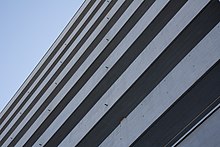Max Vogt (architect)
Max Vogt (born January 29, 1925 in Zurich ; † December 12, 2019 ) was a Swiss architect who, as SBB's in- house architect , designed numerous railway operations buildings. Buildings such as the Altstetten train station or the signal box at Zurich main station made a significant contribution to the fact that the SBB received the 2005 Wakker Prize for exemplary townscapes.
Life
From 1945 to 1949 Max Vogt studied architecture at the ETH Zurich . He then worked for three years in Robert Winkler's office . He then spent five years in Belart and Frey's office in Olten before joining SBB in 1957 in the building construction section of District Directorate III. This was responsible for building construction in the Zurich area, eastern Switzerland and Graubünden. Over a hundred buildings were built in the course of the employment relationship.
While it is common today to tender public buildings in accordance with WTO rules and have them designed by private individuals, in Max Vogt's time the SBB employed its own architects for their buildings. Since the state for railway lines and operating buildings belongs to the Swiss Confederation, the SBB itself is responsible for the building permit, while otherwise the municipalities issue building permits. This created unique conditions for Max Vogt's work: if he managed to convince his superiors of his projects, he had a free hand. This enabled works that might have had a difficult time in a municipal licensing procedure. Just think of the high-rise in Altstetten or the signal box at Zurich main station.
To an editor at the NZZ he commented on his two main works in Altstetten and at HB as “monolithic concrete cupping without expansion joints”. Indeed, exposed concrete is characteristic of Vogt's buildings. A massive concrete construction often contrasts with the masts, overhead lines and overhead lines required for technical reasons. Elsewhere, the concrete is used playfully, for example at the Altstetten high-rise railway station in Zurich : With a little imagination, a station full of trains can be seen from above in the south facade: the parapets form the platform roofs, the balconies and windows alternate between carriages.
In 1989 Max Vogt retired.
Larger works
- Bahnhof Wil SG , 1960
- Effretikon station , various buildings in 1961 and 1962
- Signal box at Zurich main station , 1963
- Thalwil station , reception building in 1963 and large shed in 1973
- Altstetten station , 1966
- Station Erlenbach ZH , 1967
- Stäfa station , 1967
- Herrliberg-Feldmeilen station, 1968
- Schaffhausen station , with:
- Administration building, 1972
- Signal box, 1968
- Goods hall, 1971
- Lokremise 1968
- Benken SG station, 1969
- Killwangen-Spreitenbach station , 1970
- Weinfelden station , service building, 1970,71
- Signal box Buchs SG , 1960, station 1980
- Signal box Zurich Mülligen, 1974
Literature and Sources
- Martin Stollenwerk: SBB buildings Max Vogt . gta Verlag Zurich 2006. ISBN 978-3-85676-204-9 .
- Philipp Bridel [author], Max Vogt [editor]: Renovation of Baden railway station, renovation of the former Dietikon station building, restoration of Zurich main station, 1980 . Zurich: District Directorate III of SBB, 1980
- Ruedi Weidmann, Karl Holenstein, Max Vogt - Building for the Railway 1957-1989 (Volume 1 of the series Architecture and Technical History of the Railways of Switzerland ), Verlag Scheideger & Spiess, Zurich 2008 ISBN 978-3-85881-185-1
Web links
- Peter Michael Keller: Max Vogt (architect). In: Historical Lexicon of Switzerland .
- Literature by and about Max Vogt in the catalog of the German National Library
Individual evidence
- ↑ SRF of December 30, 2019: SBB architect Max Vogt is dead. Raw buildings with elegance and sophistication , accessed on December 30, 2019
- ↑ Neue Zürcher Zeitung of December 30, 2019: Max Vogt has written architectural history with railway buildings made of raw concrete, by Dorothee Vögeli , accessed on December 30, 2019
- ↑ Archived copy ( memento of the original from March 18, 2014 in the Internet Archive ) Info: The archive link was inserted automatically and has not yet been checked. Please check the original and archive link according to the instructions and then remove this notice.
- ↑ http://www.bahnonline.ch/phpkit/include.php?path=forum/showthread.php&threadid=1454 ( page no longer available , search in web archives ) Info: The link was automatically marked as defective. Please check the link according to the instructions and then remove this notice.
| personal data | |
|---|---|
| SURNAME | Vogt, Max |
| BRIEF DESCRIPTION | Swiss architect |
| DATE OF BIRTH | January 29, 1925 |
| PLACE OF BIRTH | Zurich |
| DATE OF DEATH | December 12, 2019 |

